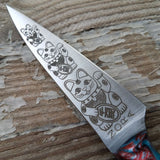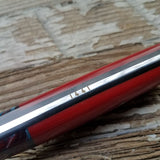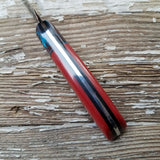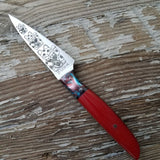







NORA #1441 - 3.5' Paring - AEB-L Stainless Steel - Maneki Neko
$ 209.00
KNIFE HIGHLIGHTS
- Blade Type: Paring
- Blade Length: 3.5 Inches
- Total Length: 8 Inches
- Handle Style: Western | Right or Left Hand Use
- Steel: 52100 Carbon Steel
- Rockwell Hardness: 61 HRC
- Grind Type: Full Flat
- Handle Materials: Red G10, Black G10 liners, Red & Teal Blue Resin (Urethane Based), Stainless Steel Pins
- Thin for Performance (best performance but also more delicate)
- >>>Thick for Durability (tough, built to last for heavy wear-n-tear)
- Mid-Range with Special Geometry (specially ground for food release and glide but blade is kept slightly thicker for durability)
- >>> Heavy in Hand (hefty, durable)
- Light (nimble, maneuverable)
- Not too heavy, not too light (Mid-Range Weight)
GENERAL USES OF THIS KNIFE
The paring knife is often overlooked but the truth is it is one of the single most-used knives in the kitchen. It is also unique with respect to where it is used...not just on a cutting board but also in hand.
With this in mind, we redesigned our paring knife to have a smaller, more nimble handle that feels great in hand and gives its user a wide amount of maneuverability. This knife works wonderfully for small tasks that are easier completed by using the knife in-hand, such as hulling a strawberry, paring fruit, or deveining shrimp.
KNIFE DESIGN INFORMATION
Every one of our knives is handmade, unique and numbered in order of production since we originally began NORA. This NORA knife, #1441, is a tribute to the famous Japanese cat, Maneki Neko.
I have to admit that I never quite understood why so many business owners randomly had these cats in their windows or stuffed up on a shelf overlooking their place. It got me curious enough that I consulted Google and was pleasantly surprised to find that these Japanese figurines are considered talismen and are believed to bring good luck to their owners. As if that wasn't enough, they're just, well, cute too.
You can never have enough cute, lucky charms as far as we are concerned. Actually, "we" isn't the right word. Steve doesn't give a sh*t but because the engraver resides firmly in my domain, I get to put cute cats on our knives if I want. (If he actually read these descriptions I might be worried that he would say something to me about my boldness, but he doesn't so my online sass remains safe for another day.)
HANDLE MATERIAL
The majority of this handle from a near indestructible material called G10. What is G10 you ask? G10 is an incredibly strong & durable fiberglass laminate that was originally used in the electronics industry. It has been adapted in the knife making world and has proven to be an excellent material for handles as it has high strength, low moisture absorption and can be found in a variety of colors. Its one of our favorite materials to work with outside of wood. We complemented this red G10 with a vivid resin that has hues of red and teal blue and we added black G10 liners and stainless steel pins.
STEEL INFORMATION:
AEB-L STAINLESS STEEL
This knife blade is composed of AEB-L stainless steel which is a high-quality Swedish metal, originally developed for razor blades. Recently, steel suppliers have made this steel available in thicker sheets and it has proven to be an excellent adaptation for the cutlery industry.
AEB-L has a beautiful balance of carbon and chromium and, with proper heat treatment, this steel produces both a very fine edge as well as excellent toughness and edge stability. The fine grain structure also makes this steel very easy to sharpen. We believe it is one of the finest stainless steels available on the market today for use with kitchen knives.
As a side note, there are two things we like to mention about this steel:
1.) This steel responds beautifully to honing and if the knife is honed regularly it should need infrequent sharpening.
2.) AEB-L is a stainless steel but just barely. The concept of stainless steel is very misleading because every steel is, at some level, reactive to water and other elements.
The higher carbon content in this stainless is what allows it to get a fine edge and higher hardness compared to many other stainless steels but it also has a tendency to sometimes form very fine rust spots on the blade. If this happens, these are easily removed with a green or red scotch brite pad and usually the rough end of a kitchen sponge will also do the trick. Take extra care to remove any excess wetness that remain on this blade. Drip drying is NOT recommended.
